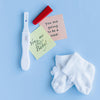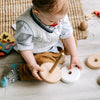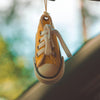How to Choose the Best Toys for Your Baby
- by Smiley Kiddo

Introduction
Selecting appropriate toys is crucial for your baby's development, as playtime significantly contributes to learning and growth. The right toys can aid in developing motor skills, sensory awareness, and cognitive abilities, while also providing entertainment.
Understanding Developmental Milestones
Recognizing your baby's developmental stages can guide you in choosing suitable toys:
-
0–3 Months:
-
One Month: Lifting head briefly during tummy time, glancing at colorful objects, making comfort sounds, moving arms and legs symmetrically.
-
Three Months: Holding chest up and rolling over during tummy time, focusing on objects, responding to sounds by making their own sounds, reaching towards toys without grasping.
-
-
4–6 Months:
-
Four Months: Reaching and grasping objects with both hands, playing with rattle toys, finding partially hidden objects, smiling at their reflection in a mirror.
-
Six Months: Rotating wrists when playing with toys, passing objects between hands, enjoying peek-a-boo, distinguishing between familiar and unfamiliar faces.
-
-
7–12 Months:
-
Seven Months: Grasping objects with fingers, making exclamatory noises, interacting with their reflection, enjoying bouncing games and dancing.
-
Twelve Months: Stacking blocks, repeating sounds or gestures that elicit laughter, offering toys to known adults, having a comfort object like a doll or blanket.
-
-
13–24 Months:
-
Thirteen Months: Pushing, pulling, and dumping things; turning pages in a book; playing alone on the floor with toys; taking things apart and playing with movable toys.
-
Twenty-Four Months: Jumping in place, kicking a ball, making scribble marks on paper, playing alongside other children, using switches, knobs, or buttons on toys.
-
Choosing Toys Based on Developmental Stages
-
0–3 Months:
- Sensory Toys: Soft plushies, crocheted or felt toys are ideal during tummy time to aid head, neck, and muscle development.
-
4–6 Months:
- Interactive Play: Engage in peek-a-boo to help them recognize partially hidden objects and develop object permanence.
-
7–12 Months:
- Building Toys: Blocks that can be stacked and knocked down enhance problem-solving skills and motor development.
-
13–24 Months:
- Active Toys: Balls for throwing and kicking encourage physical activity and coordination.
Additional Considerations When Choosing Toys
-
Safety: Ensure toys are free from small, detachable parts, strings, or fillings that could pose choking hazards. Avoid toys with hazardous magnets or easily accessible button batteries.
-
Simplicity: Babies often find joy in simple objects. Everyday items like wooden spoons can introduce decision-making and exploration.
-
Developmental Appropriateness: Select toys that match your baby's current developmental stage to encourage appropriate skill development.
Conclusion
Choosing the right toys for your baby involves understanding their developmental milestones and selecting items that promote growth, safety, and enjoyment. By providing age-appropriate toys, you support your child's physical, cognitive, and emotional development, making playtime both fun and beneficial.
Source: Baby Bunting - How to Choose the Best Toys for Your Baby
- Posted in:
- Baby Development
- Baby Play
- Kid Toys




